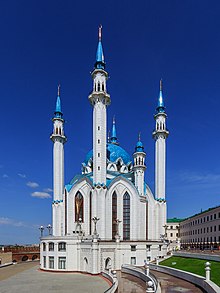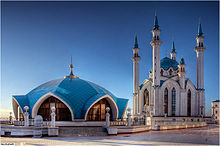User:Changantonio/New sandbox
This article relies largely or entirely on a single source. (May 2011) |
| Kul Sharif Mosque | |
|---|---|
 | |
| Religion | |
| Affiliation | Islam |
| District | Tatarstan |
| Status | Active |
| Location | |
| Location | Kazan, Russia |
| Geographic coordinates | 55°47′54.49″N 49°06′17.32″E / 55.7984694°N 49.1048111°E |
| Architecture | |
| Type | Mosque |
| Completed | 2005 |
| Specifications | |
| Capacity | 6,000 |
| Dome(s) | 1 |
| Minaret(s) | 4 |
The Kul Sharif Mosque[1][2] (Tatar: Кол Шәриф мәчете, romanized: Kul Sharif mechete; Russian: Мечеть Кул-Шариф, romanized: Mechet' Kul-Sharif) located in Kazan Kremlin, was reputed to be – at the time of its construction – one of the largest mosques in Russia, and in Europe outside of Istanbul.[3]
History
[edit]Originally, the mosque was built in the Kazan Kremlin in the 16th century. It was named after Kul Sharif, who was a religious scholar who served there. Kul Sharif died with his numerous students while defending Kazan from Russian forces in 1552. It is believed that the building featured minarets, both in the form of cupolas and tents. Its design was traditional for Volga Bulgaria, although elements of early Renaissance and Ottoman architecture could have been used as well. In 1552, during the Siege of Kazan it was destroyed by Ivan the Terrible.


Tatar scholars speculate as to whether some elements of Kul Sharif Mosque can be seen in Saint Basil's Cathedral in Moscow (8 minarets, a central cupola, not typical for Russian architecture). Since 1996, the mosque has been rebuilt in the Kazan Kremlin, although its look is decisively modern. Its inauguration on July 24, 2005, marked the beginning of celebrations dedicated to the Millennium of Kazan. It can accommodate 6,000 worshipers.
Several countries contributed to the fund that was set up to rebuild Kul Sharif Mosque, namely Saudi Arabia, and United Arab Emirates. Nowadays the mosque predominantly serves as a museum of Islam. At the same time during the major Muslim celebrations thousands of people gather there to pray.
The Kul Sharif complex was envisioned to be an important cornerstone of Kazan's architectural landscape. Besides the main mosque building it includes a library, publishing house and Imam's office.
Ivan IV Vasilyevich
[edit]Ivan IV Vasilyevich, who was also known as Ivan the Terrible, was the prince of Russia from 1533 until 1584. During Ivan’s ruling, Russia endured several hardships and changes towards their country. Ivan took great pride in being the tsar of Russia. He believed no one was his equal and if one were to defy him, it was as if they were betraying God himself. His reign was filled with complete terror as he did everything possible to rebuild Russia since he believed he was only pleasing God. Ivan's reign led to the destruction of several buildings, including Kul Sharif Mosque, which was later rebuilt and completed in 2005.
References
[edit]- ^ "Kul Sharif Mosque, Kazan, Russia - Russia Travel Guide". Travel All Russia. 2015-12-09. Retrieved 2018-09-02.
- ^ "Kul Sharif Mosque, Kazan - TripAdvisor". TripAdvisor. Retrieved 2018-09-03.
- ^ "Putin joins Tatarstan festivities". BBC News. 2005-08-26. Retrieved 2010-05-22.
External links
[edit]- "Kul Sharif (The main page)". Archived from the original on 13 September 2005. Retrieved 28 June 2009.
- Kul Sharif video
- Kul Sharif mosque on "Russian mosques"
- Kul Sharif Mosque (Kazan)
- ^ Kinossian, Nadir (2012-07). "Post-Socialist Transition and Remaking the City: Political Construction of Heritage in Tatarstan". Europe-Asia Studies. 64 (5): 879–901. doi:10.1080/09668136.2012.681270. ISSN 0966-8136.
{{cite journal}}: Check date values in:|date=(help) - ^ Shaposhnik, Viacheslav (2014-07-01). "Ivan the Terrible". Russian Studies in History. 53 (1). ISSN 1061-1983.
- ^ "ProQuest Ebook Central". ebookcentral.proquest.com. Retrieved 2019-12-09.
